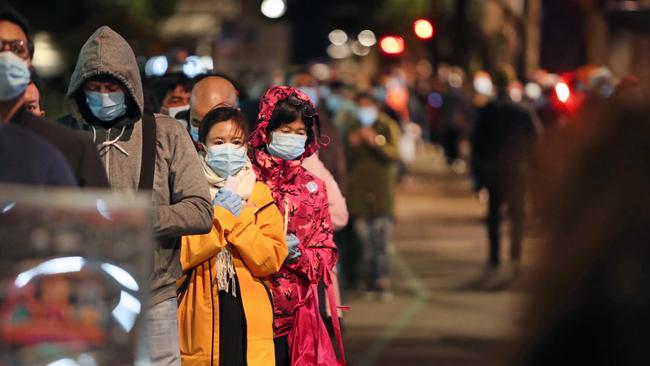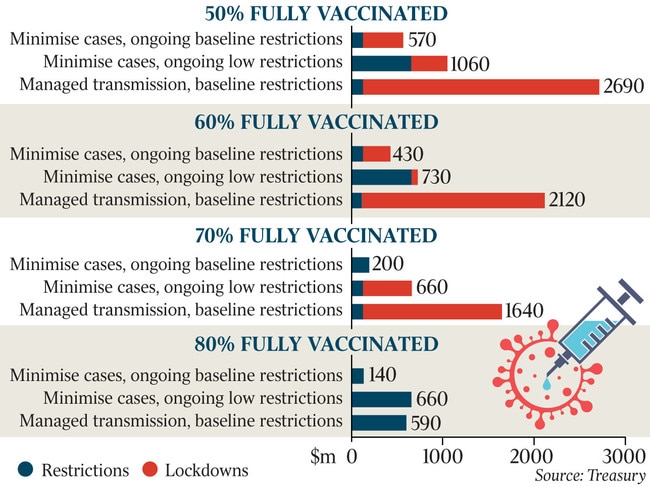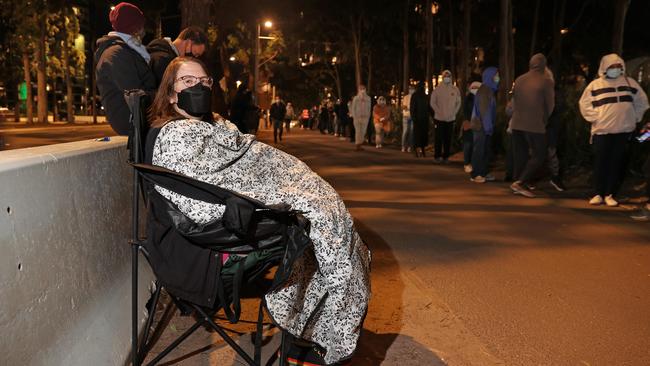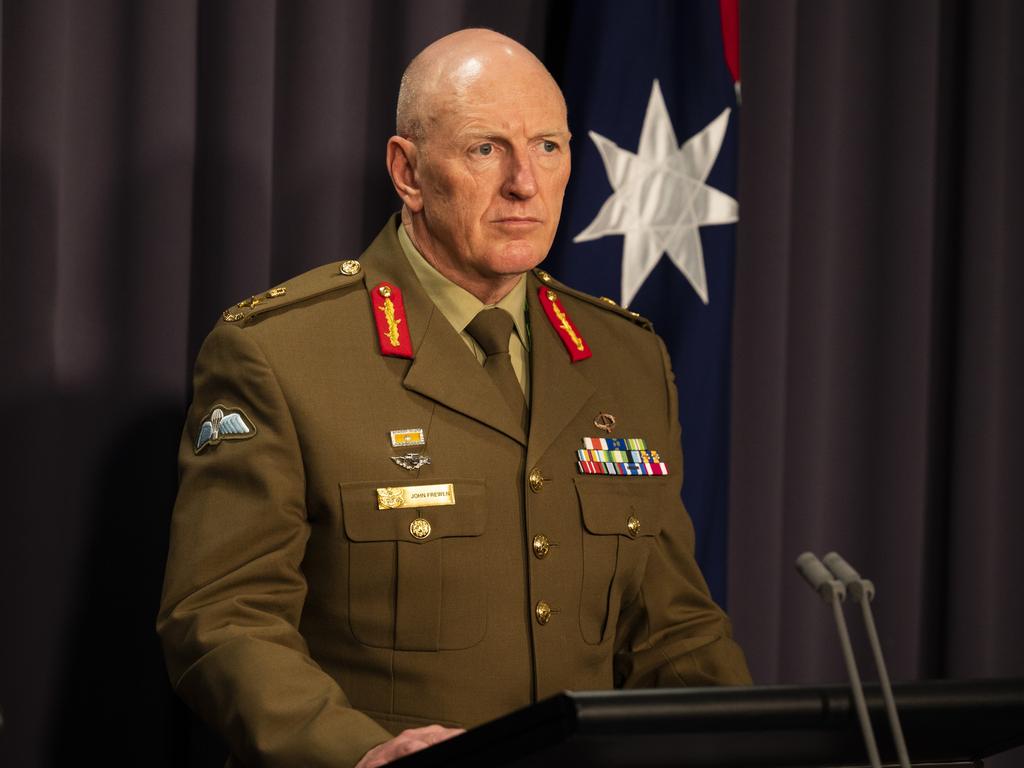Health experts debunk vaccine myths as Treasury warns of $7bn hit
Health experts have urged Australians to get jabbed with AstraZeneca, as Treasury modelling found low vaccine take-up will wipe nearly $7bn off growth every three months.

A group of the nation’s leading medical professionals have urged Australians not to wait for Pfizer and to get jabbed with AstraZeneca, as new Treasury modelling found that a lower vaccine take-up rate would wipe nearly $7bn off growth every three months.
The economic necessity of imposing short, sharp lockdowns and achieving higher inoculation rates was revealed in Treasury analysis that showed Australians would be forced into five lockdowns every quarter if vaccination coverage flatlined at 50 per cent.
In addition, Treasury found the cost of governments failing to act quickly to rein in outbreaks would rise to an even more brutal $35bn a quarter under the Delta strain.
The warning came as an alliance of prominent medical and health specialists penned an open letter debunking myths about the AstraZeneca vaccine and pleaded for all people to urgently get jabbed.
The letter, published in The Australian, reveals a growing number of doctors, professors and medical researchers are pushing back against the undermining of AstraZeneca, which they say provides similar protections against the Delta variant as Pfizer.

The public appeal includes doctors at the coal face of the Sydney outbreak and leading health professionals including: outgoing National Health and Medical Research Council chair Bruce Robinson; former deputy chief medical officer Nick Coatsworth; infectious diseases experts Tania Sorrell and Lyn Gilbert; Gardasil vaccine co-founder and former Australian of the Year Ian Frazer, and former Australian Medical Association president Steve Hambleton. The health professionals said the country was at a “critical point in the pandemic” and noted that, as NSW responded to spikes in cases and infections rose in Queensland, there were “millions of unused doses of AstraZeneca vaccine sitting in GPs’ surgeries and vaccination clinics”.
“Our strong recommendation to all Australians in an outbreak setting is to get a first dose of AstraZeneca or Pfizer vaccine as soon as possible … This is consistent with the latest Australian Technical Advisory Group on Immunisation advice,” the health professionals wrote.
“Do not wait for the Pfizer vaccine if the AstraZeneca vaccine is available to you. AstraZeneca is an excellent vaccine that has already saved millions of lives and will save many more. Covid kills, and by the time you or someone you love is infected, hospitalised or in ICU it is too late.”
They said lockdowns, while necessary to limit new cases, could not “prevent the spread of the virus” alone and caused “terrible stress and economic hardship”.
In a research paper assessing the direct economic costs of the COVID-19 management strategies modelled by the Doherty Institute, Treasury said it now assumed there would be five Covid-19 outbreaks every three months – two more than assumed in the May budget.
The lockdowns necessary to control the outbreaks would also be more prolonged.
At a vaccination rate of 50 per cent, (the current rate is 20 per cent), there would be 70 days of lockdowns on average each quarter affecting 20 per cent of the population, while there would be lower-level health measures in place for the remaining 20 days.
Over the quarter, the average weekly cost of restrictions would be $570m – or $6.8bn in total – representing a 1.4 per cent handbrake on economic growth as long as vaccination rates remained relatively low.
Jarden chief economist Carlos Cacho said the official estimates showed vaccination was the economic imperative to next year’s recovery. Mr Cacho said that under this scenario the nation’s trend annual growth rate of roughly 3 per cent would halve. The combination of low immigration, which has accounted for about half of long-term growth, and low vaccination rates would mean the economy would stagnate.

Even at 60 per cent vaccination rates and with the adoption of a swift lockdown approach, Australia would still experience 48 days of lockdown on average in each quarter, Treasury estimated.
This would have an average weekly cost of $430m – equivalent to $5.2bn over three months, or closer to 1 per cent of nominal GDP. “Moderate or strict lockdowns are still expected to be necessary to continue minimising outbreaks until Australia reaches 70 per cent vaccination rates for Australian adults (aged 16 and over),” Treasury said. “As a result, the costs of managing COVID-19 will remain high.”
By the time seven in 10 Australians aged 16 or over had received two jabs, Treasury assumed there would be only “periodic low-level restrictions” at an average cost of $200m a week or $2.4bn a quarter.
At an 80 per cent vaccination rate, the average weekly hit to economic growth would reduce to $140m or $1.7bn over a quarter.
While the costs of locking down Australians to control the spread of the virus are large, the economic damage from adopting a more laissez-faire approach to managing infections would be devastating. Assuming half the adult population was vaccinated and there was a failure to take swift action to lock down, the economic damage from more prolonged restrictions aimed at reining in infections would rise to as much as $35bn a quarter, according to the Treasury analysis.

Under this dire “managed transmission” scenario, authorities would only introduce lockdowns once the health system had reached its capacity to treat severely ill Covid patients. “Applying strict localised lockdowns, for shorter durations, is more cost-effective than applying more moderate lockdowns for longer periods,” Treasury concluded.
In their open letter, Australia’s leading health professionals outlined the low risks associated with AstraZeneca, upholding its safety and efficacy, while urging younger Australians to get vaccinated.
“Whilst the risk of death is highest in older age groups, we are now seeing serious illness and death in unvaccinated young patients. The risk, however, is also not all about simple survival. Between 10-30 per cent of people who contract Covid will suffer long-term health consequences, the seriousness of which are yet to be fully understood,” they said.







To join the conversation, please log in. Don't have an account? Register
Join the conversation, you are commenting as Logout